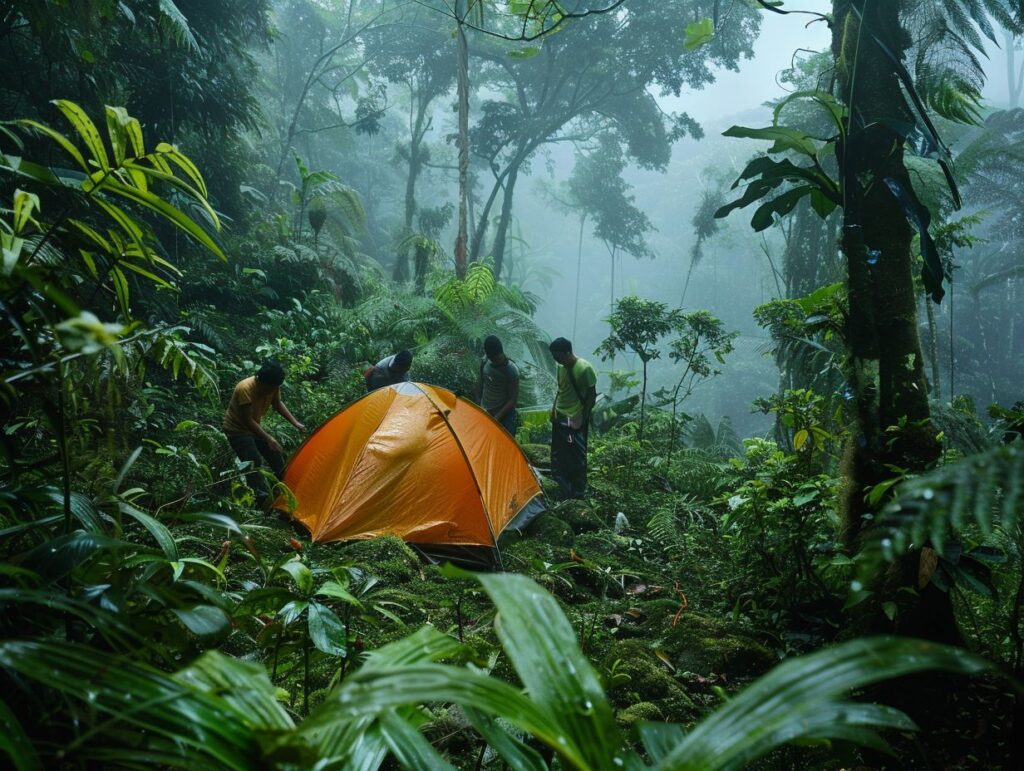Humidity can significantly impact your camping experience. This guide covers everything you need to know about camping in humid conditions. It includes information on the importance of humidity, signs of high humidity, and how to prepare for humid camping.
Learn about packing essentials, selecting the ideal campsite, and choosing appropriate attire. Stay hydrated with our recommended drinks and hydration tips. Additionally, find out how to stay cool, safety measures to take, and what to do during a thunderstorm.
Prepare yourself for a successful and enjoyable camping trip in humid weather!
Key Takeaways:
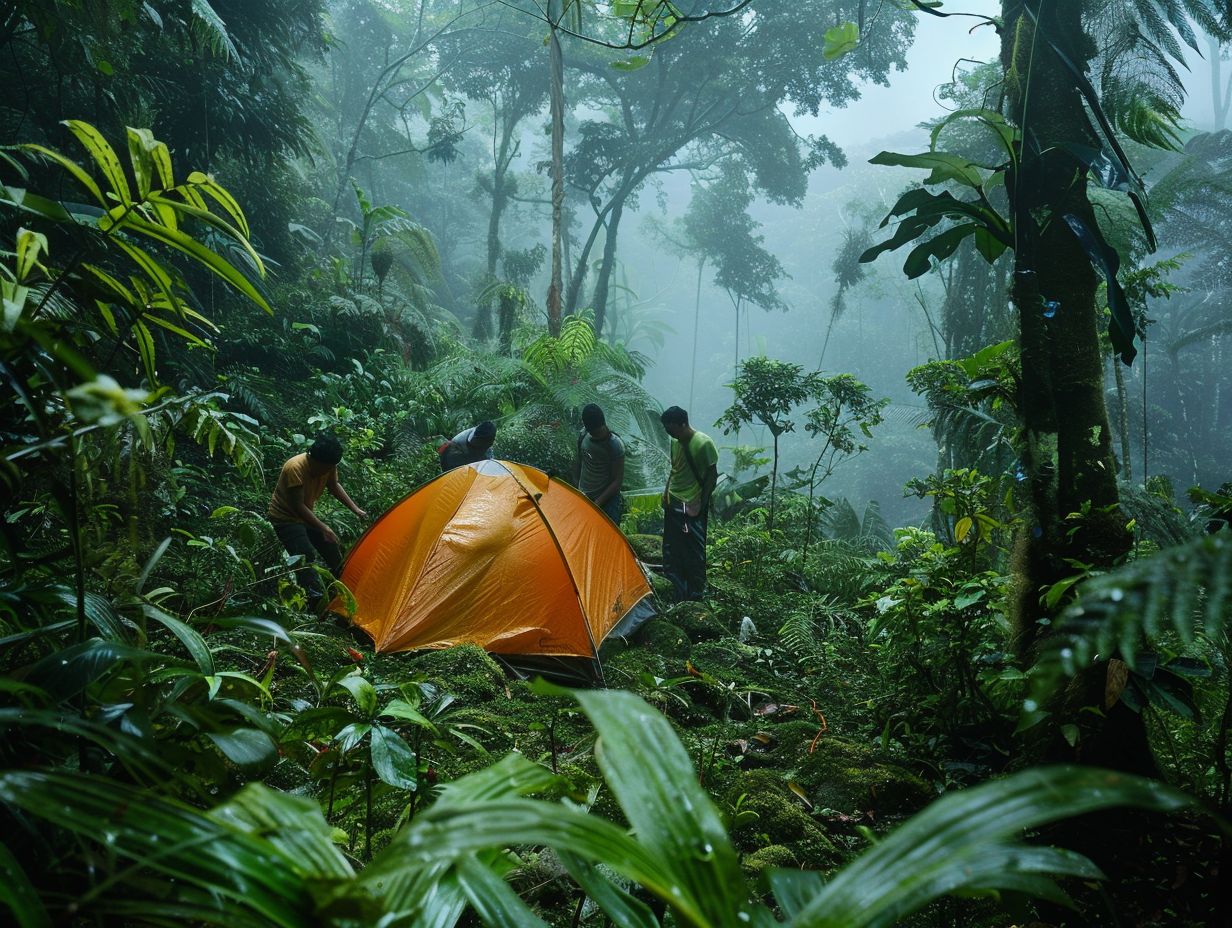
- Pack light and breathable clothing to stay comfortable in humid conditions.
- Stay hydrated by drinking plenty of water and sports drinks.
- Take necessary safety precautions during thunderstorms and protect yourself from insects and mosquitoes.
How to Prepare for Camping in Humid Conditions?
In readiness for camping in humid conditions, it is essential to carefully choose appropriate equipment, including a well-ventilated tent and a breathable sleeping bag. Additionally, preparation should account for potential weather fluctuations, and adequate hydration strategies should be established.
What to Pack for Humid Camping?
When preparing for camping in a humid environment, it is crucial to select gear constructed from breathable materials like nylon and polyester, a sleeping bag treated with Durable Water Repellent (DWR), and tools to facilitate airflow and moisture management, such as mesh organisers.
Selecting clothing crafted from moisture-wicking textiles such as merino wool or synthetic blends can assist in regulating body temperature and maintaining dryness in humid climates.
Incorporating a portable fan or a battery-operated lantern equipped with built-in ventilation can improve air circulation within the tent.
Choosing quick-drying towels and footwear tailored for water-related activities can mitigate discomfort and prevent issues like fungal infections resulting from prolonged exposure to moisture.
How to Choose a Campsite in High Humidity?
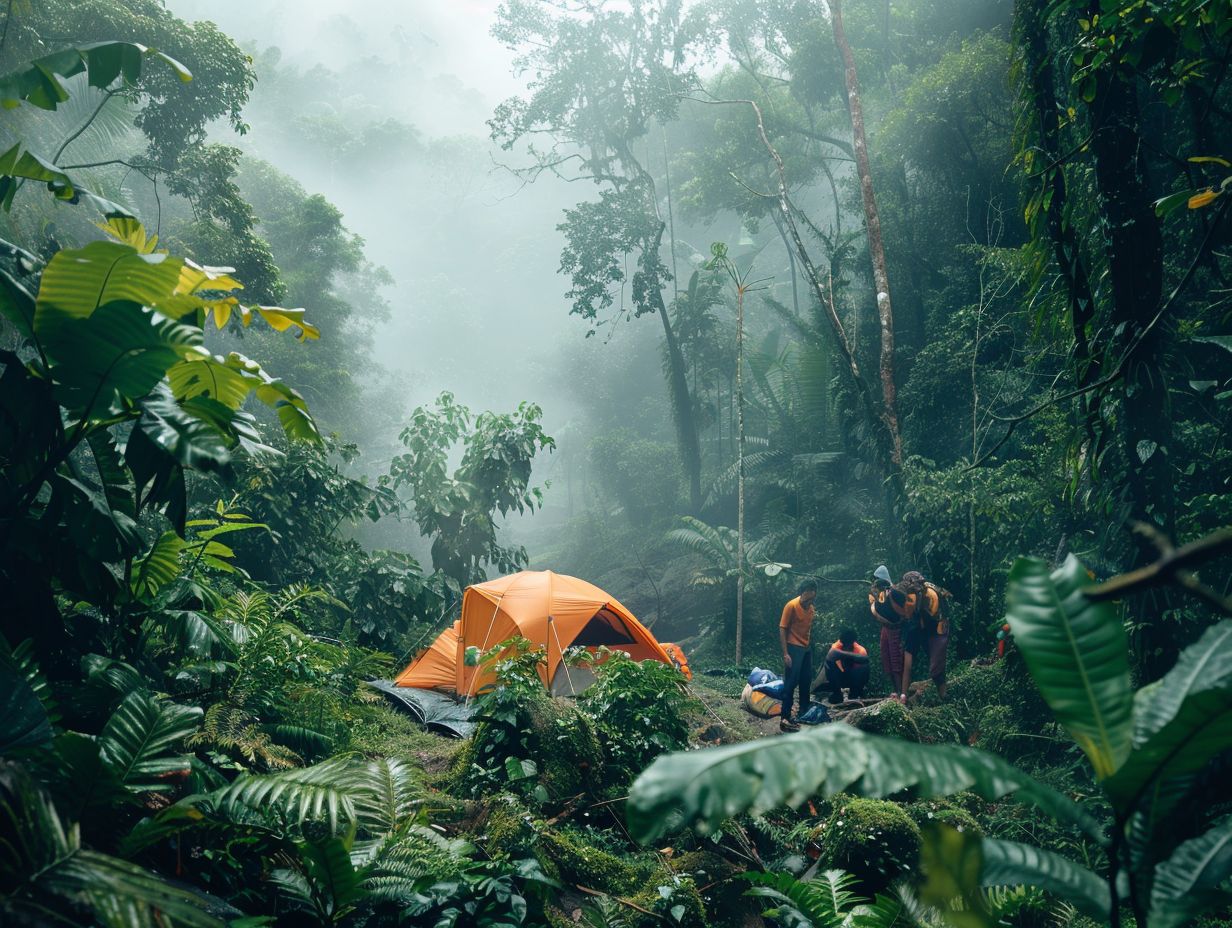
Selecting a campsite in high humidity conditions entails seeking out locations that offer natural shade and exposure to breezes, while avoiding areas directly under the sun or in low-lying regions susceptible to moisture accumulation.
An important recommendation for identifying the optimal campsite in high humidity is to consider sites near water bodies such as lakes or rivers. These areas not only provide refreshing breezes but also tend to be cooler due to the evaporative cooling effect of water.
Opting for a site at a higher elevation can assist in avoiding oppressive heat, as cooler air tends to descend from elevated positions. It is advisable to take note of the prevailing wind direction and arrange the camp setup to maximise cross breezes for natural ventilation.
What to Wear When Camping in Humid Conditions?
When camping in humid conditions, it is advisable to select lightweight and breathable fabrics such as cotton. This choice will not only ensure your comfort but also allow your skin to breathe effectively. Fabrics like linen and rayon are highly recommended due to their moisture-wicking properties, which assist in keeping you dry and cool.
Additionally, garments featuring mesh panels or vents can significantly improve breathability and airflow. Another viable option is to opt for moisture-wicking synthetic materials like polyester or nylon. These materials aid in the rapid evaporation of sweat, thereby reducing clamminess.
It is important to steer clear of heavy fabrics like wool as they have the propensity to trap heat and moisture, resulting in a sticky and uncomfortable sensation, particularly in humid environments.
How to Stay Hydrated in Humid Conditions?
Maintaining proper hydration in humid conditions is essential due to the diminished efficacy of the body’s cooling mechanism through perspiration, thereby heightening the susceptibility to dehydration and heat-related ailments.
What are the Best Drinks for Hydration in Humid Conditions?
The most suitable beverages for maintaining hydration in humid conditions are water, electrolyte solutions, and hydrating drinks that facilitate the restoration of lost minerals and the preservation of fluid balance.
Coconut water stands out as an exceptional choice, primarily due to its inherent electrolytes, including potassium and magnesium, which play a critical role in supporting proper muscle function and preventing cramping.
Additionally, sports drinks are widely favored for their ability to replenish electrolytes that are depleted through perspiration during vigorous physical exertion.
Moreover, herbal teas, such as peppermint or chamomile, offer both hydration benefits and soothing effects on the digestive system.
Incorporating a variety of these hydrating beverages into daily consumption habits can significantly contribute to maintaining optimal levels of hydration and promoting overall well-being.
How Much Water Should You Drink in Humid Conditions?
During humid conditions, it is advisable to consume a minimum of 8-10 ounces of water every 20-30 minutes in order to maintain proper hydration levels, as outlined by the Environment Agency.
This regular intake of water holds particular importance in humid environments where elevated temperatures and heightened perspiration rates accelerate the dehydration process. Vigilant monitoring of fluid intake is imperative; recognising indicators such as dark urine, feelings of dizziness, or a dry mouth can signify the necessity for increased water consumption.
Adapting the volume of water ingested according to individual activity levels and the duration of exposure to humidity is paramount. The consistent presence of a refillable water container and the practice of consuming water intermittently throughout the day are effective methods for sustaining optimal hydration levels.
What are the Signs of Dehydration in Humid Conditions?
Indications of dehydration in high humidity environments may manifest as dry mouth, dizziness, dark-coloured urine, and a pervasive sense of fatigue and debility.
It is imperative to identify these symptoms promptly, as dehydration can progress to more severe manifestations such as elevated heart rate, cognitive disorientation, sunken eyes, and reduced perspiration. Severe dehydration can precipitate syncope, hypotension, and potential organ failure if not addressed promptly.
Through a comprehensive comprehension of the diverse symptoms associated with dehydration, individuals can promptly address the condition by consuming fluids or seeking medical intervention to restore hydration levels and avert further complications.
How to Stay Cool in Humid Conditions?
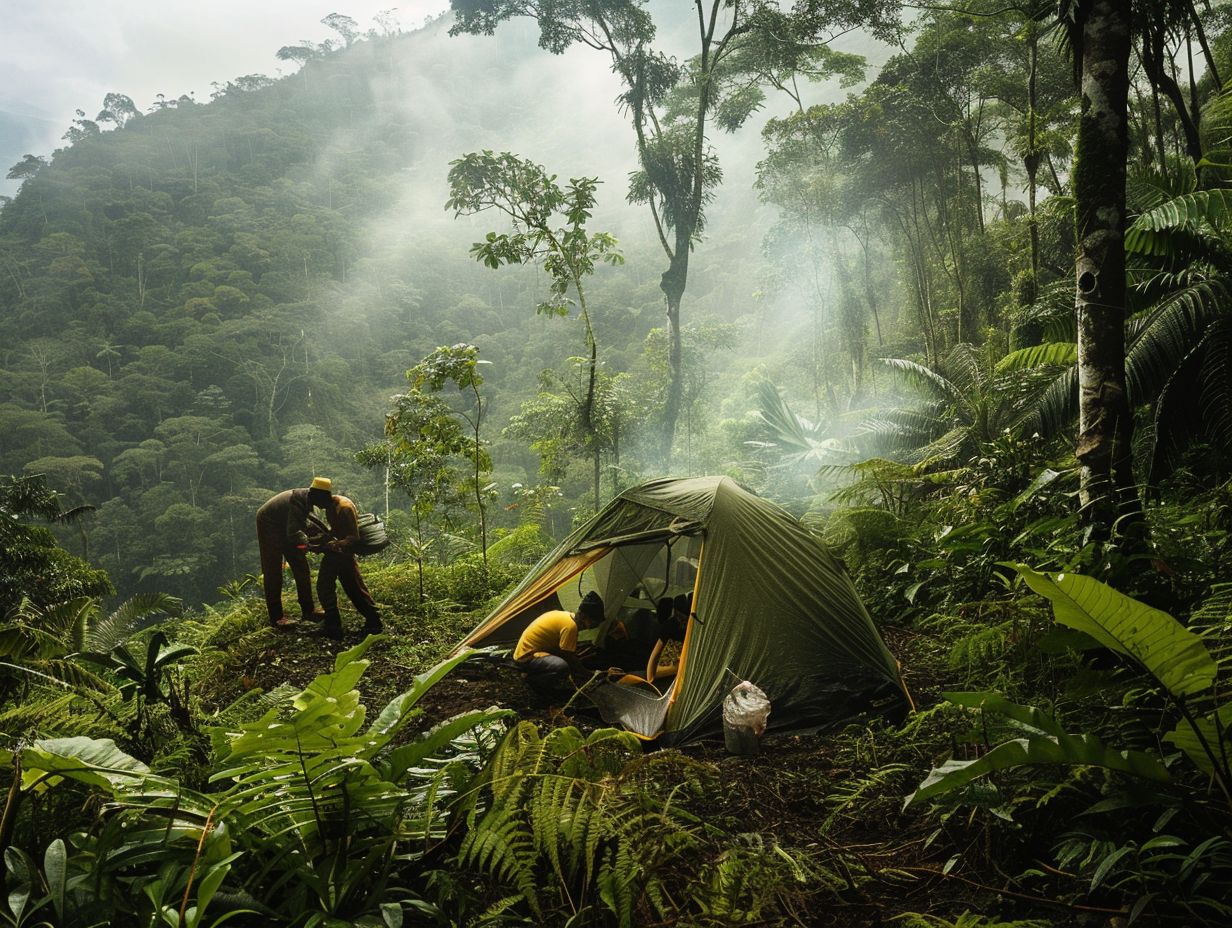
Maintaining comfort in humid environments requires the implementation of a variety of strategies, including:
- Seeking shelter from direct sunlight
- Using portable fans
- Dressing in breathable fabrics
- Incorporating regular breaks to reduce the risk of overheating and ensure optimal comfort
What are the Best Ways to Keep Your Tent Cool in Humid Conditions?
To maintain a cool interior in humid conditions within your tent, it is recommended to choose a tent equipped with mesh panels to facilitate better ventilation. Positioning the tent in a shaded area and utilising portable fans to enhance airflow and minimise condensation buildup are also advisable strategies.
The selection of a tent with an adjustable rainfly to increase airflow can further optimise ventilation within the tent. Placing a ground tarp underneath the tent can assist in regulating the internal temperature. Opting for tents in light colors is suggested, as they have a lower heat absorption rate from the sun.
For additional cooling measures, hanging damp towels inside the tent can aid in lowering the temperature. Moreover, investing in a high-quality tent fan or a battery-powered air conditioner can significantly improve the comfort level during warm weather camping excursions.
What are the Best Ways to Stay Cool While Hiking in Humid Conditions?
Whilst engaging in hiking activities under humid conditions, it is advisable to prioritise wearing breathable clothing, taking periodic breaks in shaded areas, and maintaining proper hydration levels to regulate body temperature and mitigate the risk of heat exhaustion.
Opting for moisture-wicking fabrics such as polyester or merino wool can facilitate the removal of sweat from the body, thereby reducing the likelihood of chafing and discomfort.
Incorporating electrolyte-rich beverages or snacks in your provisions can aid in replenishing vital minerals that are depleted through perspiration, thereby supporting optimal bodily functions. It is imperative to exercise caution, heed your body’s signals, and avoid excessive strain to prevent overexertion.
Furthermore, scheduling hikes during early morning or late afternoon hours can limit exposure to intense midday heat, thus enhancing overall comfort and safety while traversing hiking trails.
What are the Safety Precautions for Camping in Humid Conditions?
When camping in humid conditions, it is imperative to implement safety measures. These include:
- Monitoring weather forecasts for the possibility of thunderstorms
- Applying insect repellents to guard against mosquitoes
- Ensuring that your campsite is arranged in a manner that can endure abrupt weather fluctuations
What to Do in Case of a Thunderstorm?
If there is a thunderstorm during a camping trip, it is imperative to immediately seek shelter within a structurally sound building or your vehicle. It is advisable to avoid open areas and tall objects, while also ensuring that your tent is adequately secured against high winds and heavy precipitation.
It is important to note that lightning strikes can occur even if the storm is not directly overhead. Therefore, it is essential to remain indoors until the threat has subsided.
If one finds themselves in an exposed area without access to shelter, it is recommended to assume a crouching position with minimal contact between the body and the ground to reduce the likelihood of a lightning strike.
Furthermore, individuals are advised to steer clear of bodies of water, metal objects, and electronic devices during a thunderstorm as these elements can attract lightning. Disconnecting electronic devices and refraining from using plumbing fixtures during a thunderstorm are also sensible precautions to prevent electric shocks.
How to Protect Yourself from Insects and Mosquitoes in Humid Conditions?
Protecting oneself from insects and mosquitoes in humid conditions necessitates the use of insect repellents, wearing long-sleeved tops and trousers, and putting up mosquito nets or mesh screens around the tent and sleeping area.
Also, using citronella candles, insect-repellent lamps, or portable mosquito traps can be crucial in creating a protective barrier against unwanted pests. Moreover, investing in permethrin-treated clothing or equipment provides long-lasting protection by keeping away insects like ticks and mosquitoes.
It is vital to carefully check camping equipment for any small gaps or tears that insects could use to enter. By taking these preventive measures, individuals can ensure a more comfortable and enjoyable camping experience free from annoying insect bites.
Frequently Asked Questions
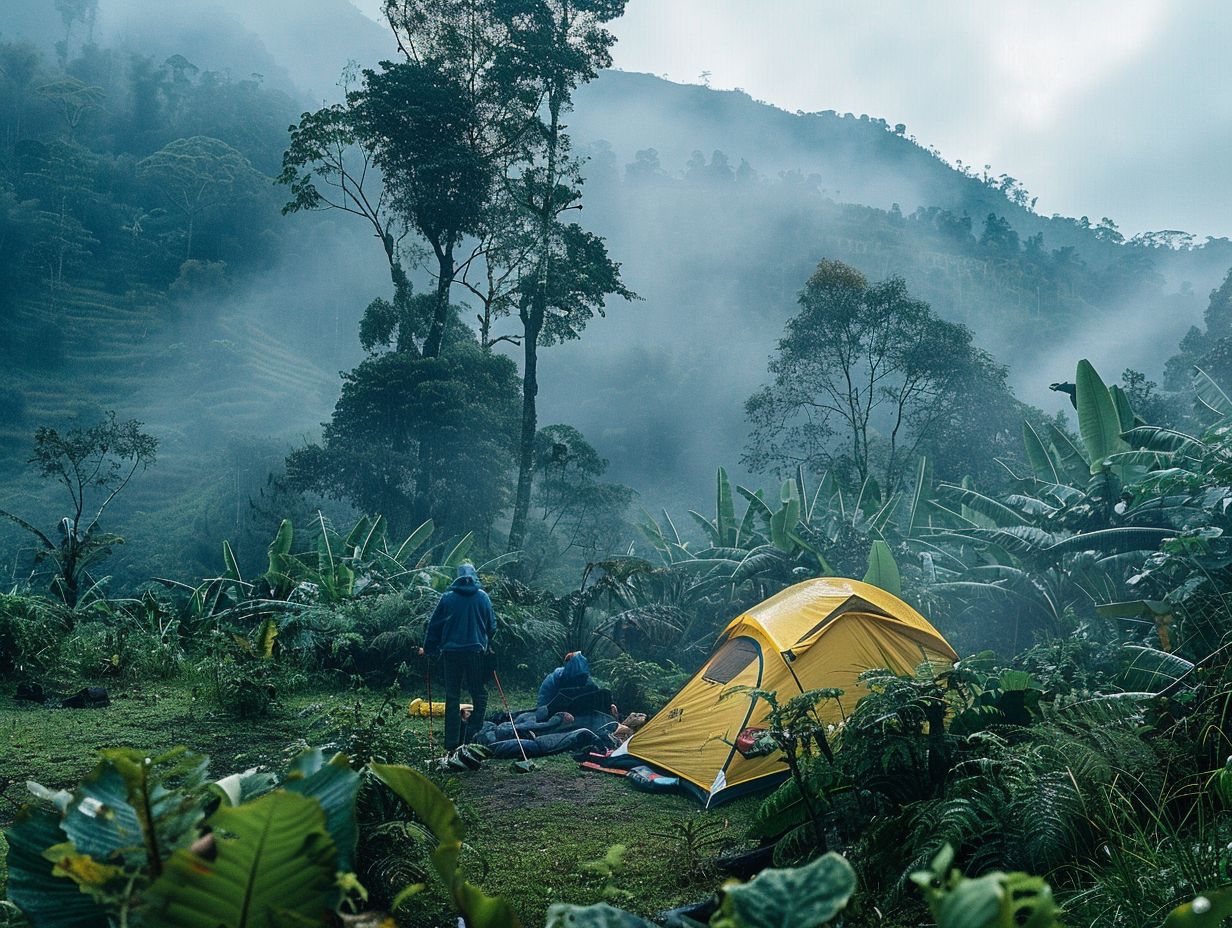
What are some tips for staying dry while camping in humid conditions?
1. Choose a tent with good ventilation to help prevent condensation and keep the air inside dry.
2. Bring a rain fly or tarp to cover your tent in case of rain.
3. Use a waterproof ground cloth or tarp underneath your tent to keep moisture from seeping in.
4. Avoid setting up camp in low-lying areas or near bodies of water where humidity tends to be higher.
5. Bring quick-drying camping gear and clothing to change into if you get wet.
6. Use a dehumidifier or moisture absorbent products inside your tent to help keep the air dry.
How can I protect my electronics and other gear from the humidity while camping?
1. Keep your electronics in a waterproof bag or case to prevent moisture damage.
2. Use silica gel packets to absorb moisture in your bags or containers.
3. Keep your gear elevated off the ground to avoid any potential flooding or condensation.
4. Invest in a waterproof cover for your backpack or other gear.
5. Plan ahead and pack only essential electronics to minimise the risk of damage.
6. Check the weather forecast before your trip and plan accordingly to avoid heavy rain or humidity.
What should I wear while camping in humid conditions?
1. Choose lightweight and breathable clothing made of moisture-wicking materials.
2. Avoid cotton clothing, as it tends to absorb and retain moisture.
3. Wear loose-fitting clothes to allow for better air circulation.
4. Consider bringing a rain jacket or poncho in case of unexpected rain.
5. Wear a hat to protect your head from the sun and to help keep you cool.
6. Bring extra socks and change them regularly to keep your feet dry and prevent blisters.
How can I protect myself from insect bites while camping in humid conditions?
1. Use insect repellent with DEET to keep bugs away.
2. Wear long-sleeved shirts and pants to cover up exposed skin.
3. Avoid camping near standing water, as it attracts mosquitoes.
4. Keep your camping area clean and free of trash to avoid attracting bugs.
5. Use citronella candles or torches to repel insects.
6. Wear light-coloured clothing, as darker colours tend to attract bugs.
What food should I bring on a camping trip in humid conditions?
1. Pack non-perishable foods, such as dried fruits, nuts, and energy bars, to avoid spoilage.
2. Consider bringing a portable cooler and ice packs for perishable items.
3. Avoid bringing foods that need to be refrigerated or need to be cooked.
4. Bring plenty of water to stay hydrated in the humid weather.
5. Plan your meals and bring only what you need to minimise food waste.
6. Pack foods that are easy to prepare and require minimal cooking time.
What are some safety tips to keep in mind while camping in humid conditions?
1. Check the weather forecast before your trip and be prepared for potential rains or storms.
2. Avoid setting up camp under trees or near tall objects that could attract lightning.
3. Stay hydrated and drink plenty of water throughout the day.
4. Take frequent breaks and rest in cooler, shaded areas.
5. Avoid overexerting yourself and take breaks from strenuous activities.
6. Keep a first aid kit handy and know basic first aid for heat-related illnesses such as heat exhaustion or heatstroke.

